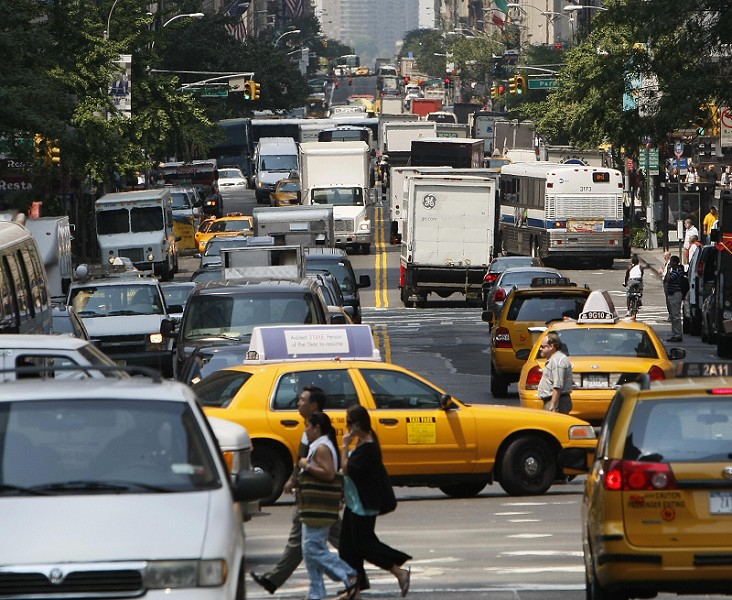
ILMRT
What makes New York City what it is today is the ease with which commuters can get around without a personal vehicle. Even now, as cities like Los Angeles and Seattle invest billions in public transit, New York has by far the most extensive transit system and the lowest rates of car ownership in the country. It is no exaggeration to say that New York exists as it does—in all of its density, in all of its opportunity—because we have a transit system that allows residents to forego owning a private vehicle.
But commuting via transit is becoming harder and harder as our subways, buses and commuter rail networks continue to face funding shortfalls and service declines: MTA data shows subway delays skyrocketing from roughly 20,000 a month in 2012 to over 67,000 by May 2017, while bus speeds have plummeted 15 percent citywide between 2002 and 2015. The result? In a recent report, New York City’s Independent Budget Office (IBO) estimated that “There were 34,900 passenger hours of delay during the morning rush on a typical weekday in May of this year, a 45.3 percent increase since 2012. . . IBO calculated this lost time is worth as much as $280 million a year.” Meanwhile, public transit is becoming increasingly unaffordable, with one in four poor New Yorkers unable to pay to ride subways or buses when they need to.
The scale of the crisis has elected officials scrambling at long last to find solutions; unfortunately, however, they disagree on the answer. Governor Andrew Cuomo has proposed congestion pricing as the solution, going so far as to empanel a task force charged with figuring out how to fix congestion and generate revenue for transit. Mayor Bill de Blasio, meanwhile, has argued that congestion pricing would require poor New Yorkers who drive to spend more; instead, he has advanced a millionaires’ tax and has included as part of that the “Fair Fares” proposal spearheaded by Community Service Society (CSS) and Riders Alliance and supported by a majority of New York’s City Council and dozens of organizations citywide.
As transit advocates, we are often asked: which one is the “right” plan? The reality is that both proposals have merit—but the mayor’s specious argument that congestion pricing is regressive does not. And this isn’t just a guess; thanks to a new analysis of U.S. Census data by CSS, we know that only 4 percent of outer-borough residents commute to jobs in Manhattan using a private vehicle—and among the working poor, that number falls to 2 percent. Meanwhile, 58 percent of the working poor in the outer boroughs rely on public transit to get to work. In fact, most households in the city do not own cars, and those that do are disproportionately wealthier. Data my organization, Tri-State Transportation Campaign, released on Car-Free Day last April showed just how great the disparity in car ownership is: in New York City, 54.5 percent of households are car-free, and the median income of households with no vehicles is $40,630, compared to $85,000 for households that own cars.
If you choose to drive into the most transit-dense region of the United States, that’s a choice you should be allowed to make. But it shouldn’t be free. Virtually every other commuter into midtown and lower Manhattan pays, whether it’s bus, subway, or commuter rail fares, ferry tickets, or CitiBike user fees. Car drivers do not deserve a free ride while everyone else pays their fair share. Aside from that fundamental inequity, the negative externalities of car use—congestion, pollution, and safety hazards—are reason enough to charge drivers for the true cost of single-occupancy vehicles. And with virtually every other major bridge in the New York metropolitan region subject to a toll, there’s no reason to leave the Queensboro, Williamsburg, Manhattan and Brooklyn bridges toll-free.
The answer is clear: the most progressive thing we can do is fix our subways, buses, and commuter rail—and make them affordable for the people who rely on transit most. That means raising new revenues for public transit, and whether that’s done via congestion pricing or a millionaires’ tax (or both), it must be done. The cost of inaction is the slow failure of the transit system that is the backbone of our city and the economic engine of the entire region. That is truly the price we cannot afford to pay.
Nick Sifuentes is the executive director of the Tri-State Transportation Campaign, an advocacy organization dedicated to reducing car dependency in New York, New Jersey, and Connecticut.









3 thoughts on “CityViews: Congestion Pricing Isn’t Regressive—Failing to Fix Transit Is”
Pingback: Today’s Headlines – Streetsblog New York City
NYC needs congestion pricing.
It just makes sense here.
The ‘Move NY’ plan has many good points, particularly cashless tolling on the East River crossings and lower tolls on the Verrazano, Whitestone and Throggs Neck bridges. http://iheartmoveny.org/
Car owning households are more well-off. But aren’t these the people you want to keep in NYC? Why penalize the people whose taxes make the city work.
If you exclude Manhattan 52% of NYC households own at least 1 vehicle – https://files.acrobat.com/a/preview/8cc0dc67-3c3e-4cd0-a788-8356c6454f09